A Report on Inequality and Employment Challenges for Ethnic Minorities
VerifiedAdded on 2023/01/20
|9
|2149
|27
Report
AI Summary
This report delves into the pervasive issue of employment inequality faced by minority ethnic groups, examining the nature and extent of disparities such as pay gaps and occupational segregation. It highlights the challenges these groups encounter, including prejudice and discrimination, and explores the underlying theoretical frameworks that contribute to these inequalities, referencing the works of sociologists like Max Weber and Karl Marx. The report further analyzes the impacts of such inequalities, leading to social and economic issues. It then evaluates relevant policies and approaches, specifically focusing on the UK's Equality Act 2010, and discusses methods to reduce inequality. The report concludes by emphasizing the need for increased awareness and continued efforts to address these challenges, advocating for more inclusive workplaces and societies.

INEQUALITY MINORITY ETHNIC GROUPS FACE IN EMPLOYMENT
The above title suggests that you are looking only at the experiences of people who are in
employment. What about those who are outside the employment? Surely they are also with ion
the scope of your report. Put a more appropriate title such as - report on the experiences of
inequality people from minority ethnic communities face in employment
The above title suggests that you are looking only at the experiences of people who are in
employment. What about those who are outside the employment? Surely they are also with ion
the scope of your report. Put a more appropriate title such as - report on the experiences of
inequality people from minority ethnic communities face in employment
Paraphrase This Document
Need a fresh take? Get an instant paraphrase of this document with our AI Paraphraser
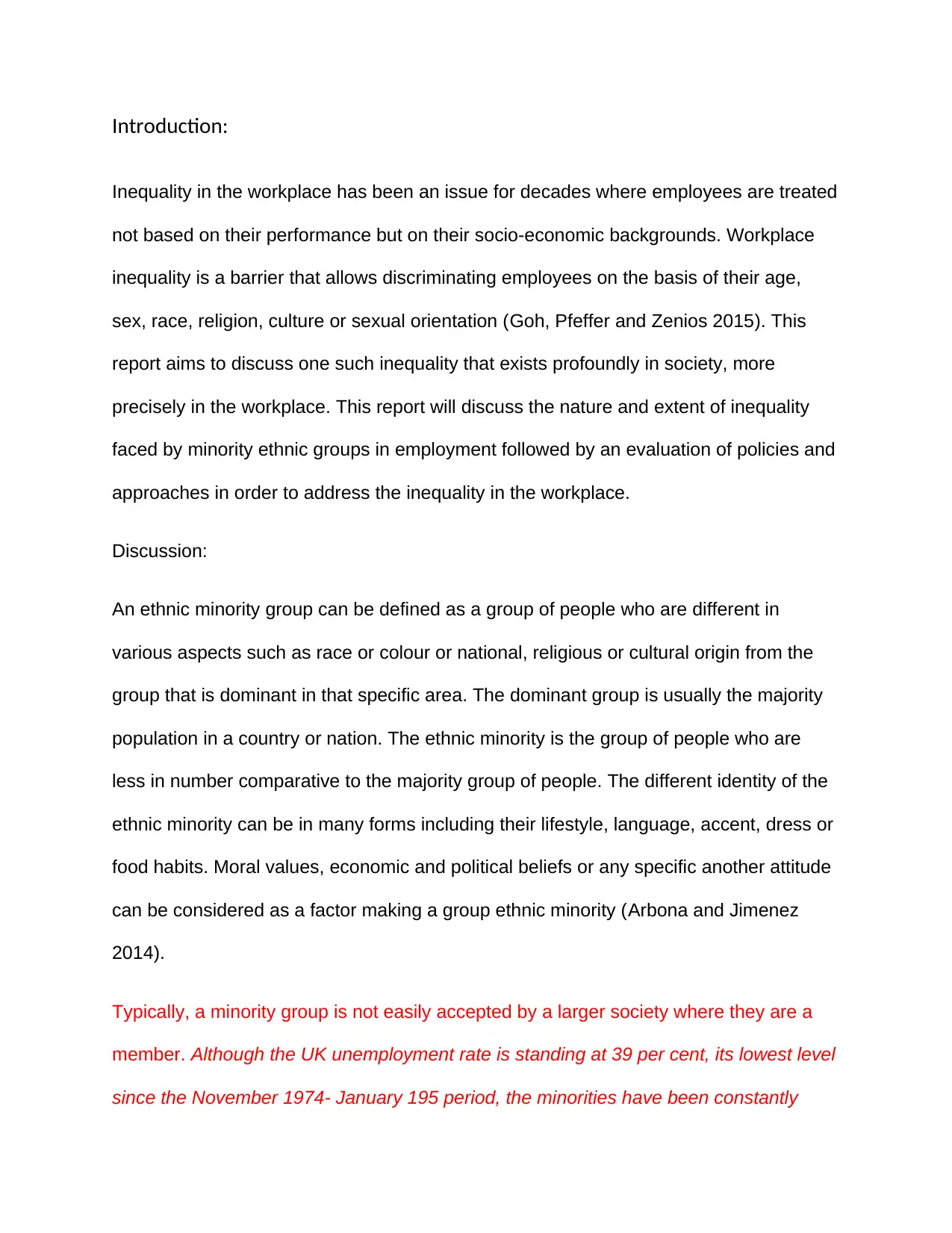
Introduction:
Inequality in the workplace has been an issue for decades where employees are treated
not based on their performance but on their socio-economic backgrounds. Workplace
inequality is a barrier that allows discriminating employees on the basis of their age,
sex, race, religion, culture or sexual orientation (Goh, Pfeffer and Zenios 2015). This
report aims to discuss one such inequality that exists profoundly in society, more
precisely in the workplace. This report will discuss the nature and extent of inequality
faced by minority ethnic groups in employment followed by an evaluation of policies and
approaches in order to address the inequality in the workplace.
Discussion:
An ethnic minority group can be defined as a group of people who are different in
various aspects such as race or colour or national, religious or cultural origin from the
group that is dominant in that specific area. The dominant group is usually the majority
population in a country or nation. The ethnic minority is the group of people who are
less in number comparative to the majority group of people. The different identity of the
ethnic minority can be in many forms including their lifestyle, language, accent, dress or
food habits. Moral values, economic and political beliefs or any specific another attitude
can be considered as a factor making a group ethnic minority (Arbona and Jimenez
2014).
Typically, a minority group is not easily accepted by a larger society where they are a
member. Although the UK unemployment rate is standing at 39 per cent, its lowest level
since the November 1974- January 195 period, the minorities have been constantly
Inequality in the workplace has been an issue for decades where employees are treated
not based on their performance but on their socio-economic backgrounds. Workplace
inequality is a barrier that allows discriminating employees on the basis of their age,
sex, race, religion, culture or sexual orientation (Goh, Pfeffer and Zenios 2015). This
report aims to discuss one such inequality that exists profoundly in society, more
precisely in the workplace. This report will discuss the nature and extent of inequality
faced by minority ethnic groups in employment followed by an evaluation of policies and
approaches in order to address the inequality in the workplace.
Discussion:
An ethnic minority group can be defined as a group of people who are different in
various aspects such as race or colour or national, religious or cultural origin from the
group that is dominant in that specific area. The dominant group is usually the majority
population in a country or nation. The ethnic minority is the group of people who are
less in number comparative to the majority group of people. The different identity of the
ethnic minority can be in many forms including their lifestyle, language, accent, dress or
food habits. Moral values, economic and political beliefs or any specific another attitude
can be considered as a factor making a group ethnic minority (Arbona and Jimenez
2014).
Typically, a minority group is not easily accepted by a larger society where they are a
member. Although the UK unemployment rate is standing at 39 per cent, its lowest level
since the November 1974- January 195 period, the minorities have been constantly
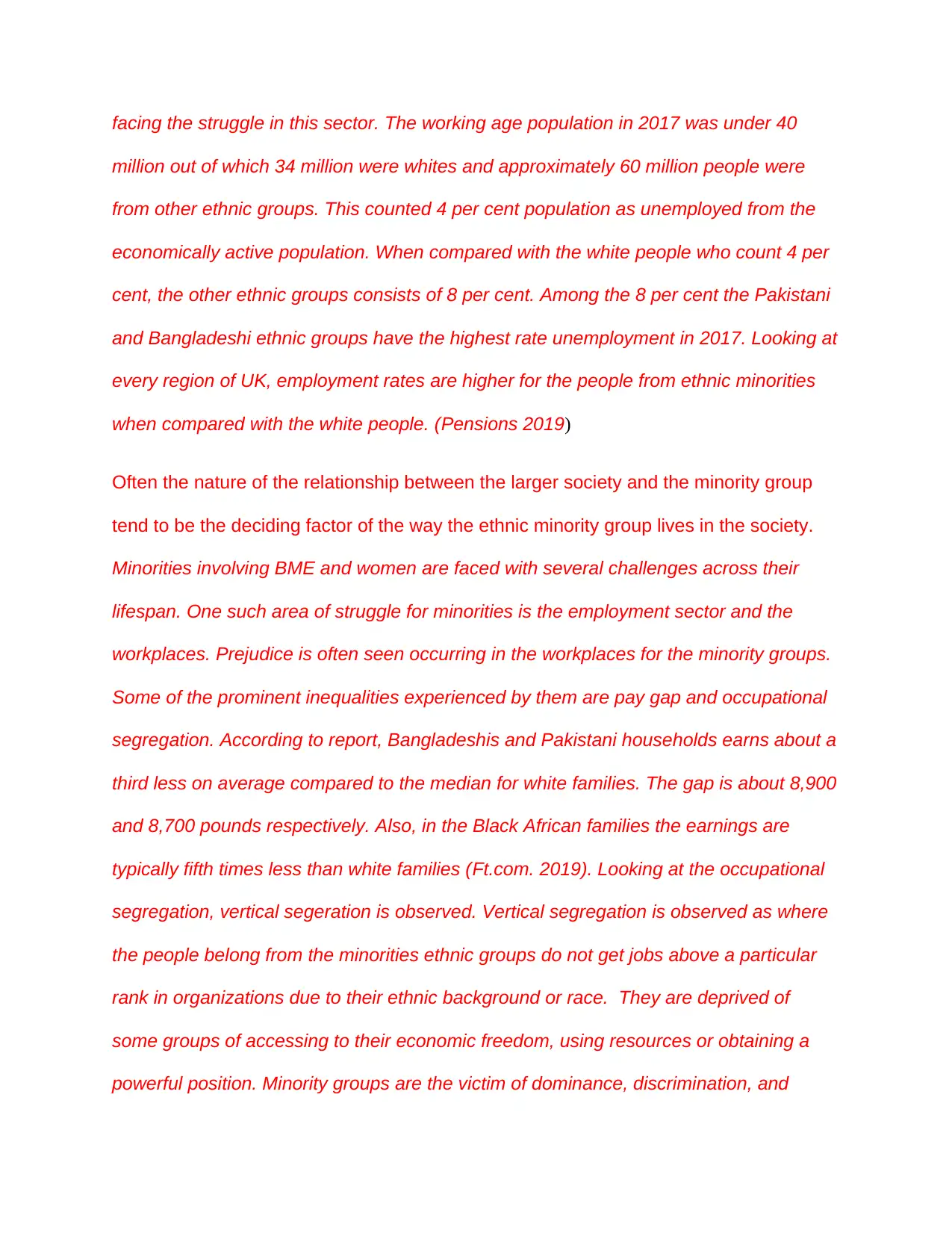
facing the struggle in this sector. The working age population in 2017 was under 40
million out of which 34 million were whites and approximately 60 million people were
from other ethnic groups. This counted 4 per cent population as unemployed from the
economically active population. When compared with the white people who count 4 per
cent, the other ethnic groups consists of 8 per cent. Among the 8 per cent the Pakistani
and Bangladeshi ethnic groups have the highest rate unemployment in 2017. Looking at
every region of UK, employment rates are higher for the people from ethnic minorities
when compared with the white people. (Pensions 2019)
Often the nature of the relationship between the larger society and the minority group
tend to be the deciding factor of the way the ethnic minority group lives in the society.
Minorities involving BME and women are faced with several challenges across their
lifespan. One such area of struggle for minorities is the employment sector and the
workplaces. Prejudice is often seen occurring in the workplaces for the minority groups.
Some of the prominent inequalities experienced by them are pay gap and occupational
segregation. According to report, Bangladeshis and Pakistani households earns about a
third less on average compared to the median for white families. The gap is about 8,900
and 8,700 pounds respectively. Also, in the Black African families the earnings are
typically fifth times less than white families (Ft.com. 2019). Looking at the occupational
segregation, vertical segeration is observed. Vertical segregation is observed as where
the people belong from the minorities ethnic groups do not get jobs above a particular
rank in organizations due to their ethnic background or race. They are deprived of
some groups of accessing to their economic freedom, using resources or obtaining a
powerful position. Minority groups are the victim of dominance, discrimination, and
million out of which 34 million were whites and approximately 60 million people were
from other ethnic groups. This counted 4 per cent population as unemployed from the
economically active population. When compared with the white people who count 4 per
cent, the other ethnic groups consists of 8 per cent. Among the 8 per cent the Pakistani
and Bangladeshi ethnic groups have the highest rate unemployment in 2017. Looking at
every region of UK, employment rates are higher for the people from ethnic minorities
when compared with the white people. (Pensions 2019)
Often the nature of the relationship between the larger society and the minority group
tend to be the deciding factor of the way the ethnic minority group lives in the society.
Minorities involving BME and women are faced with several challenges across their
lifespan. One such area of struggle for minorities is the employment sector and the
workplaces. Prejudice is often seen occurring in the workplaces for the minority groups.
Some of the prominent inequalities experienced by them are pay gap and occupational
segregation. According to report, Bangladeshis and Pakistani households earns about a
third less on average compared to the median for white families. The gap is about 8,900
and 8,700 pounds respectively. Also, in the Black African families the earnings are
typically fifth times less than white families (Ft.com. 2019). Looking at the occupational
segregation, vertical segeration is observed. Vertical segregation is observed as where
the people belong from the minorities ethnic groups do not get jobs above a particular
rank in organizations due to their ethnic background or race. They are deprived of
some groups of accessing to their economic freedom, using resources or obtaining a
powerful position. Minority groups are the victim of dominance, discrimination, and
⊘ This is a preview!⊘
Do you want full access?
Subscribe today to unlock all pages.

Trusted by 1+ million students worldwide

prejudice behaviour. Due to these specific reasons they often become socially
backward groups. They lack job security compared to the white employee. Most of the
BME are assigned to peripheral job roles as well as part-time job roles (Mendez and
Font 2014). The ethnic minority groups are boycotted from the regions that would make
them realism of their rights in the workplace. Also, they are often offered with little power
as a bonus that would make them feel privileged and not seek for their actual rights
(Azuh, Egharevba and Azuh 2016).
The reasons for the high level of discrimination can be justified by the theories. Power
helps a person achieve their goals in life. According to the sociologist Max Weber,
power is the ability of an individual or group to achieve their aims or goals while others
are making an effort to prevent them from realizing it. Weber has also identified power
as being either coercive or authoritative. Authoritative power is when the exercising
power is legitimate or they are using the power with consent (Gerth and Mills 2014). In
order to achieve own goals, the group in majority tend to use the power to dominate the
minority group. In the workplace, minority groups are discriminated in order to prevent
them from growth and achieving the position of power. They are not given the position
even when they do hold the eligibility as it will allow them access to power. The German
sociologist and economist Karl Marx, there is a limited amount of power in society
including political, social and economic powers and it is only one group at a time that
can enjoy it (Miletzki and Broten 2017). Therefore, there is a privilege that the groups in
power, white people enjoy which will be in danger once the groups who are not in
power, minorities and the BAME group claims there to share. It is through prejudice and
discrimination towards those groups that these groups maintain their status, power, and
backward groups. They lack job security compared to the white employee. Most of the
BME are assigned to peripheral job roles as well as part-time job roles (Mendez and
Font 2014). The ethnic minority groups are boycotted from the regions that would make
them realism of their rights in the workplace. Also, they are often offered with little power
as a bonus that would make them feel privileged and not seek for their actual rights
(Azuh, Egharevba and Azuh 2016).
The reasons for the high level of discrimination can be justified by the theories. Power
helps a person achieve their goals in life. According to the sociologist Max Weber,
power is the ability of an individual or group to achieve their aims or goals while others
are making an effort to prevent them from realizing it. Weber has also identified power
as being either coercive or authoritative. Authoritative power is when the exercising
power is legitimate or they are using the power with consent (Gerth and Mills 2014). In
order to achieve own goals, the group in majority tend to use the power to dominate the
minority group. In the workplace, minority groups are discriminated in order to prevent
them from growth and achieving the position of power. They are not given the position
even when they do hold the eligibility as it will allow them access to power. The German
sociologist and economist Karl Marx, there is a limited amount of power in society
including political, social and economic powers and it is only one group at a time that
can enjoy it (Miletzki and Broten 2017). Therefore, there is a privilege that the groups in
power, white people enjoy which will be in danger once the groups who are not in
power, minorities and the BAME group claims there to share. It is through prejudice and
discrimination towards those groups that these groups maintain their status, power, and
Paraphrase This Document
Need a fresh take? Get an instant paraphrase of this document with our AI Paraphraser
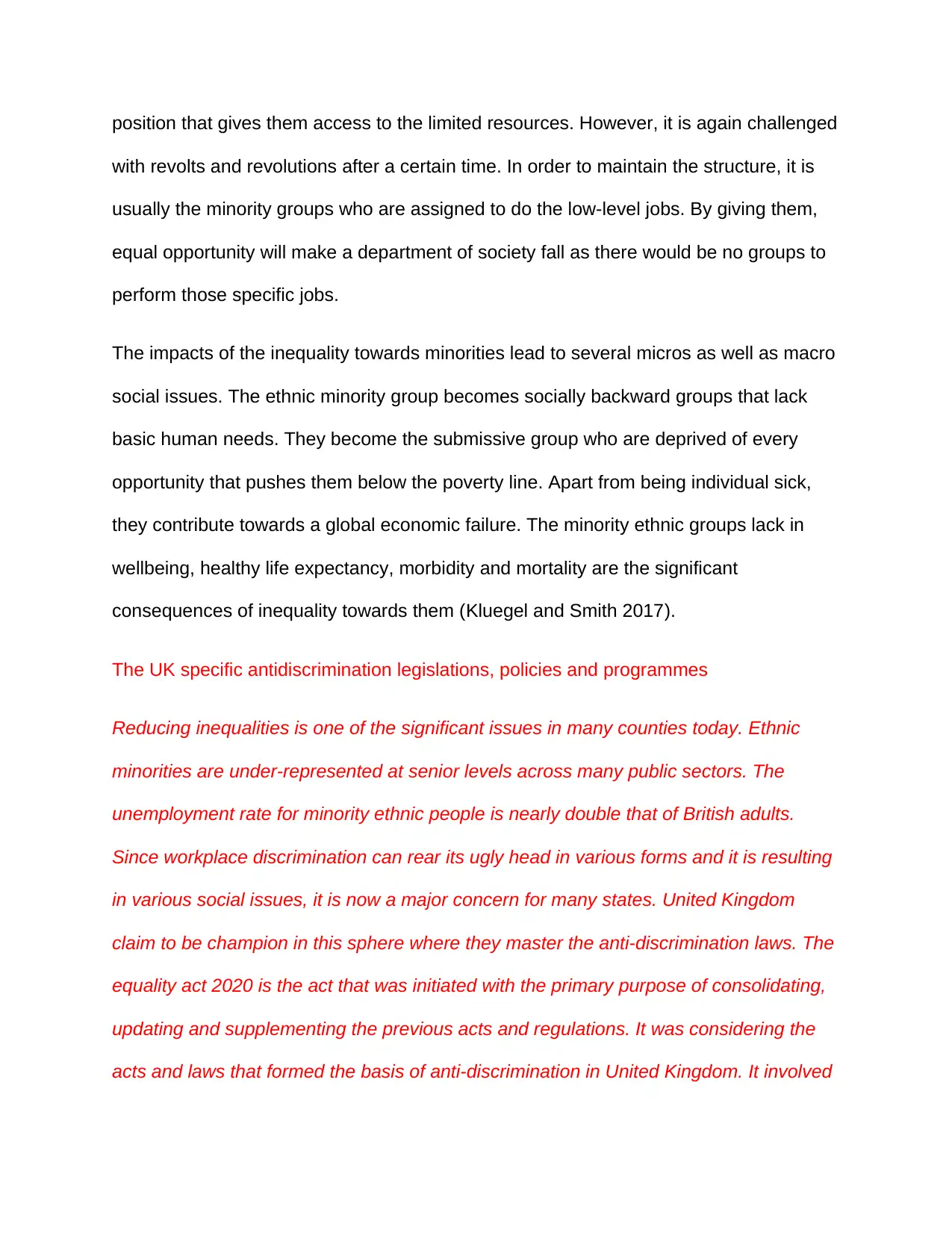
position that gives them access to the limited resources. However, it is again challenged
with revolts and revolutions after a certain time. In order to maintain the structure, it is
usually the minority groups who are assigned to do the low-level jobs. By giving them,
equal opportunity will make a department of society fall as there would be no groups to
perform those specific jobs.
The impacts of the inequality towards minorities lead to several micros as well as macro
social issues. The ethnic minority group becomes socially backward groups that lack
basic human needs. They become the submissive group who are deprived of every
opportunity that pushes them below the poverty line. Apart from being individual sick,
they contribute towards a global economic failure. The minority ethnic groups lack in
wellbeing, healthy life expectancy, morbidity and mortality are the significant
consequences of inequality towards them (Kluegel and Smith 2017).
The UK specific antidiscrimination legislations, policies and programmes
Reducing inequalities is one of the significant issues in many counties today. Ethnic
minorities are under-represented at senior levels across many public sectors. The
unemployment rate for minority ethnic people is nearly double that of British adults.
Since workplace discrimination can rear its ugly head in various forms and it is resulting
in various social issues, it is now a major concern for many states. United Kingdom
claim to be champion in this sphere where they master the anti-discrimination laws. The
equality act 2020 is the act that was initiated with the primary purpose of consolidating,
updating and supplementing the previous acts and regulations. It was considering the
acts and laws that formed the basis of anti-discrimination in United Kingdom. It involved
with revolts and revolutions after a certain time. In order to maintain the structure, it is
usually the minority groups who are assigned to do the low-level jobs. By giving them,
equal opportunity will make a department of society fall as there would be no groups to
perform those specific jobs.
The impacts of the inequality towards minorities lead to several micros as well as macro
social issues. The ethnic minority group becomes socially backward groups that lack
basic human needs. They become the submissive group who are deprived of every
opportunity that pushes them below the poverty line. Apart from being individual sick,
they contribute towards a global economic failure. The minority ethnic groups lack in
wellbeing, healthy life expectancy, morbidity and mortality are the significant
consequences of inequality towards them (Kluegel and Smith 2017).
The UK specific antidiscrimination legislations, policies and programmes
Reducing inequalities is one of the significant issues in many counties today. Ethnic
minorities are under-represented at senior levels across many public sectors. The
unemployment rate for minority ethnic people is nearly double that of British adults.
Since workplace discrimination can rear its ugly head in various forms and it is resulting
in various social issues, it is now a major concern for many states. United Kingdom
claim to be champion in this sphere where they master the anti-discrimination laws. The
equality act 2020 is the act that was initiated with the primary purpose of consolidating,
updating and supplementing the previous acts and regulations. It was considering the
acts and laws that formed the basis of anti-discrimination in United Kingdom. It involved

of equal pay act 1970, race relation act 1976 and many more. These acts are in order to
protect ethnic minorities from racial discrimination. Employers are not allowed to fire or
discipline an employee for their race. Any employee who is paid less only due to their
race can seek helps using Title VII against their employer. In any case, if an employer
fails to provide benefits, opportunities or a promotion to an employee due to their race is
liable for legal actions. The Equal pay act also prohibits employers from improperly
classifying or segregating employees or applicants on the basis of their race. Along with
the above mentioned lines, employment agencies are also prohibited from making
decisions in regard to any referrals or work assignments on the basis of an individual’s
race. Also, labour unions and representatives are prohibited to refuse any membership
or expelling of an individual on the basis of their race (Act, 2010).
The years have been a struggle for people belong from minority groups. Government
policies, non-profit organizations, have improved social mobility in the United Kingdom.
However, there is a significant lack of policies that require attention. Report have
displayed that the past twenty years failed to significantly reduce the gap between the
‘have and have not’. The methods of reducing inequality between the majority and
minorities have been increasing in wage for the lowest paid workers. Expanding the
earned income tax is another way of reducing the gap between the two groups. Build
access for middle working families and investing in education along with ending
residential segregation are some of the ways states today are trying to reduce the
economic inequality in a working sector that would later result to eliminating inequality
(Myrdal 2017).
Conclusion:
protect ethnic minorities from racial discrimination. Employers are not allowed to fire or
discipline an employee for their race. Any employee who is paid less only due to their
race can seek helps using Title VII against their employer. In any case, if an employer
fails to provide benefits, opportunities or a promotion to an employee due to their race is
liable for legal actions. The Equal pay act also prohibits employers from improperly
classifying or segregating employees or applicants on the basis of their race. Along with
the above mentioned lines, employment agencies are also prohibited from making
decisions in regard to any referrals or work assignments on the basis of an individual’s
race. Also, labour unions and representatives are prohibited to refuse any membership
or expelling of an individual on the basis of their race (Act, 2010).
The years have been a struggle for people belong from minority groups. Government
policies, non-profit organizations, have improved social mobility in the United Kingdom.
However, there is a significant lack of policies that require attention. Report have
displayed that the past twenty years failed to significantly reduce the gap between the
‘have and have not’. The methods of reducing inequality between the majority and
minorities have been increasing in wage for the lowest paid workers. Expanding the
earned income tax is another way of reducing the gap between the two groups. Build
access for middle working families and investing in education along with ending
residential segregation are some of the ways states today are trying to reduce the
economic inequality in a working sector that would later result to eliminating inequality
(Myrdal 2017).
Conclusion:
⊘ This is a preview!⊘
Do you want full access?
Subscribe today to unlock all pages.

Trusted by 1+ million students worldwide
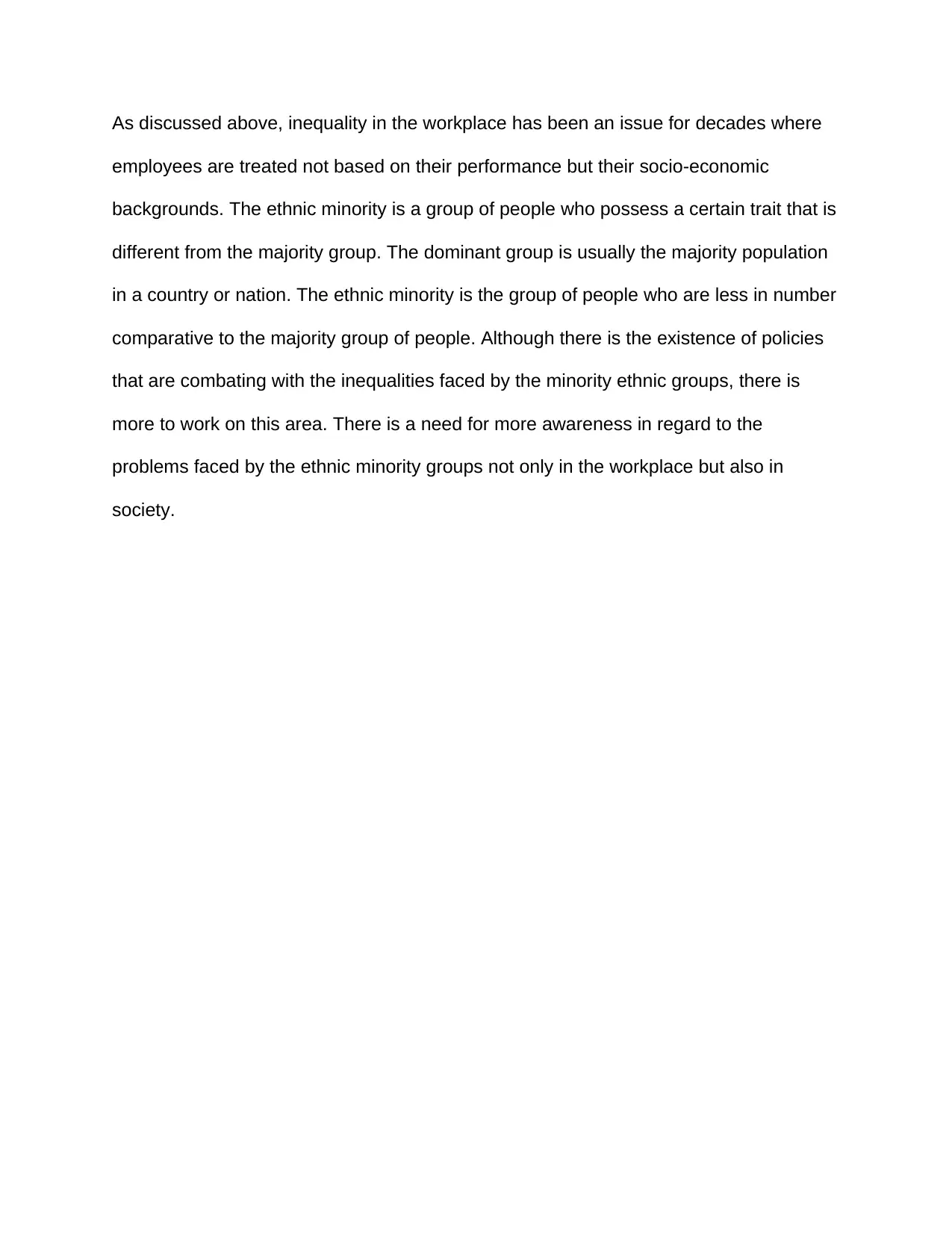
As discussed above, inequality in the workplace has been an issue for decades where
employees are treated not based on their performance but their socio-economic
backgrounds. The ethnic minority is a group of people who possess a certain trait that is
different from the majority group. The dominant group is usually the majority population
in a country or nation. The ethnic minority is the group of people who are less in number
comparative to the majority group of people. Although there is the existence of policies
that are combating with the inequalities faced by the minority ethnic groups, there is
more to work on this area. There is a need for more awareness in regard to the
problems faced by the ethnic minority groups not only in the workplace but also in
society.
employees are treated not based on their performance but their socio-economic
backgrounds. The ethnic minority is a group of people who possess a certain trait that is
different from the majority group. The dominant group is usually the majority population
in a country or nation. The ethnic minority is the group of people who are less in number
comparative to the majority group of people. Although there is the existence of policies
that are combating with the inequalities faced by the minority ethnic groups, there is
more to work on this area. There is a need for more awareness in regard to the
problems faced by the ethnic minority groups not only in the workplace but also in
society.
Paraphrase This Document
Need a fresh take? Get an instant paraphrase of this document with our AI Paraphraser
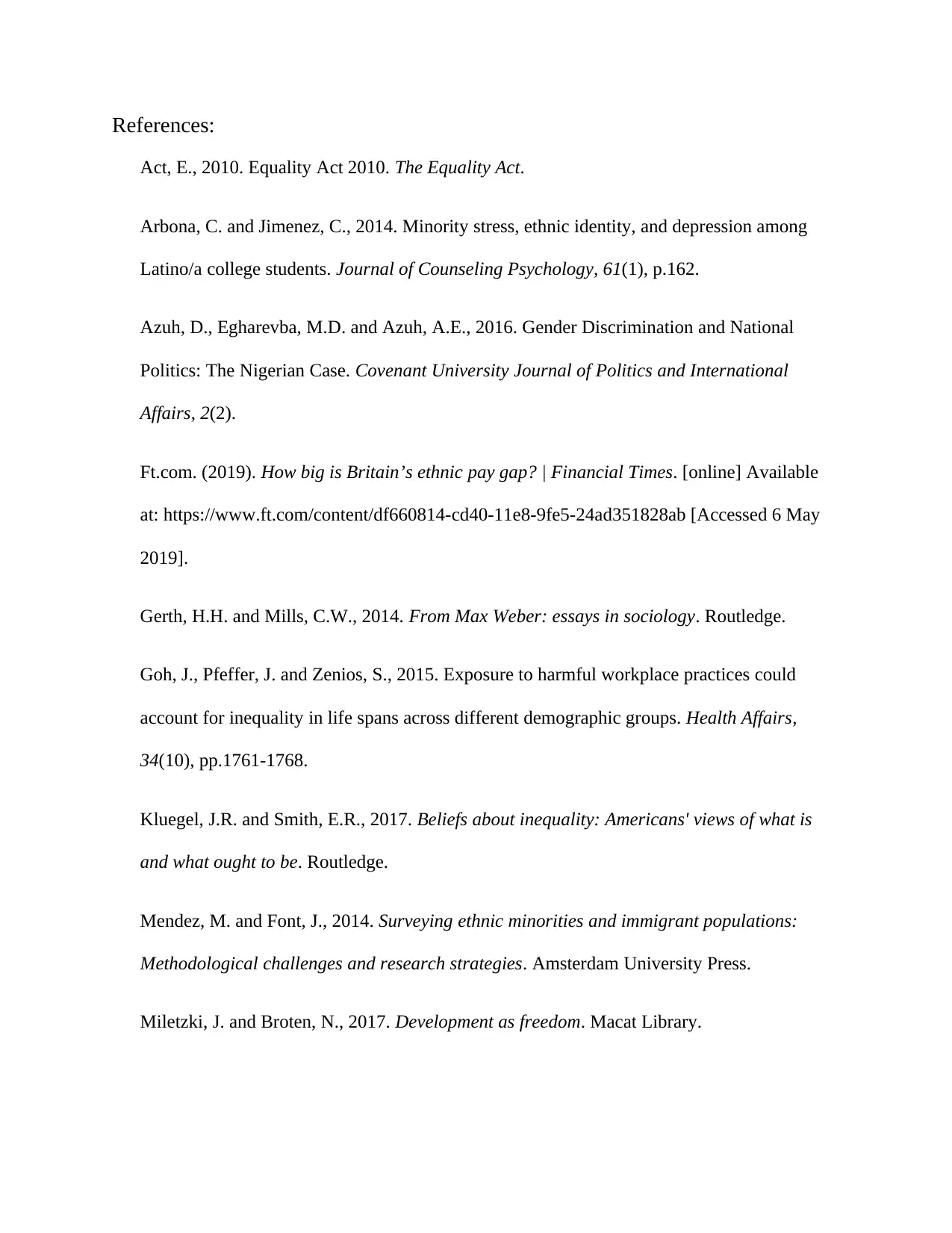
References:
Act, E., 2010. Equality Act 2010. The Equality Act.
Arbona, C. and Jimenez, C., 2014. Minority stress, ethnic identity, and depression among
Latino/a college students. Journal of Counseling Psychology, 61(1), p.162.
Azuh, D., Egharevba, M.D. and Azuh, A.E., 2016. Gender Discrimination and National
Politics: The Nigerian Case. Covenant University Journal of Politics and International
Affairs, 2(2).
Ft.com. (2019). How big is Britain’s ethnic pay gap? | Financial Times. [online] Available
at: https://www.ft.com/content/df660814-cd40-11e8-9fe5-24ad351828ab [Accessed 6 May
2019].
Gerth, H.H. and Mills, C.W., 2014. From Max Weber: essays in sociology. Routledge.
Goh, J., Pfeffer, J. and Zenios, S., 2015. Exposure to harmful workplace practices could
account for inequality in life spans across different demographic groups. Health Affairs,
34(10), pp.1761-1768.
Kluegel, J.R. and Smith, E.R., 2017. Beliefs about inequality: Americans' views of what is
and what ought to be. Routledge.
Mendez, M. and Font, J., 2014. Surveying ethnic minorities and immigrant populations:
Methodological challenges and research strategies. Amsterdam University Press.
Miletzki, J. and Broten, N., 2017. Development as freedom. Macat Library.
Act, E., 2010. Equality Act 2010. The Equality Act.
Arbona, C. and Jimenez, C., 2014. Minority stress, ethnic identity, and depression among
Latino/a college students. Journal of Counseling Psychology, 61(1), p.162.
Azuh, D., Egharevba, M.D. and Azuh, A.E., 2016. Gender Discrimination and National
Politics: The Nigerian Case. Covenant University Journal of Politics and International
Affairs, 2(2).
Ft.com. (2019). How big is Britain’s ethnic pay gap? | Financial Times. [online] Available
at: https://www.ft.com/content/df660814-cd40-11e8-9fe5-24ad351828ab [Accessed 6 May
2019].
Gerth, H.H. and Mills, C.W., 2014. From Max Weber: essays in sociology. Routledge.
Goh, J., Pfeffer, J. and Zenios, S., 2015. Exposure to harmful workplace practices could
account for inequality in life spans across different demographic groups. Health Affairs,
34(10), pp.1761-1768.
Kluegel, J.R. and Smith, E.R., 2017. Beliefs about inequality: Americans' views of what is
and what ought to be. Routledge.
Mendez, M. and Font, J., 2014. Surveying ethnic minorities and immigrant populations:
Methodological challenges and research strategies. Amsterdam University Press.
Miletzki, J. and Broten, N., 2017. Development as freedom. Macat Library.
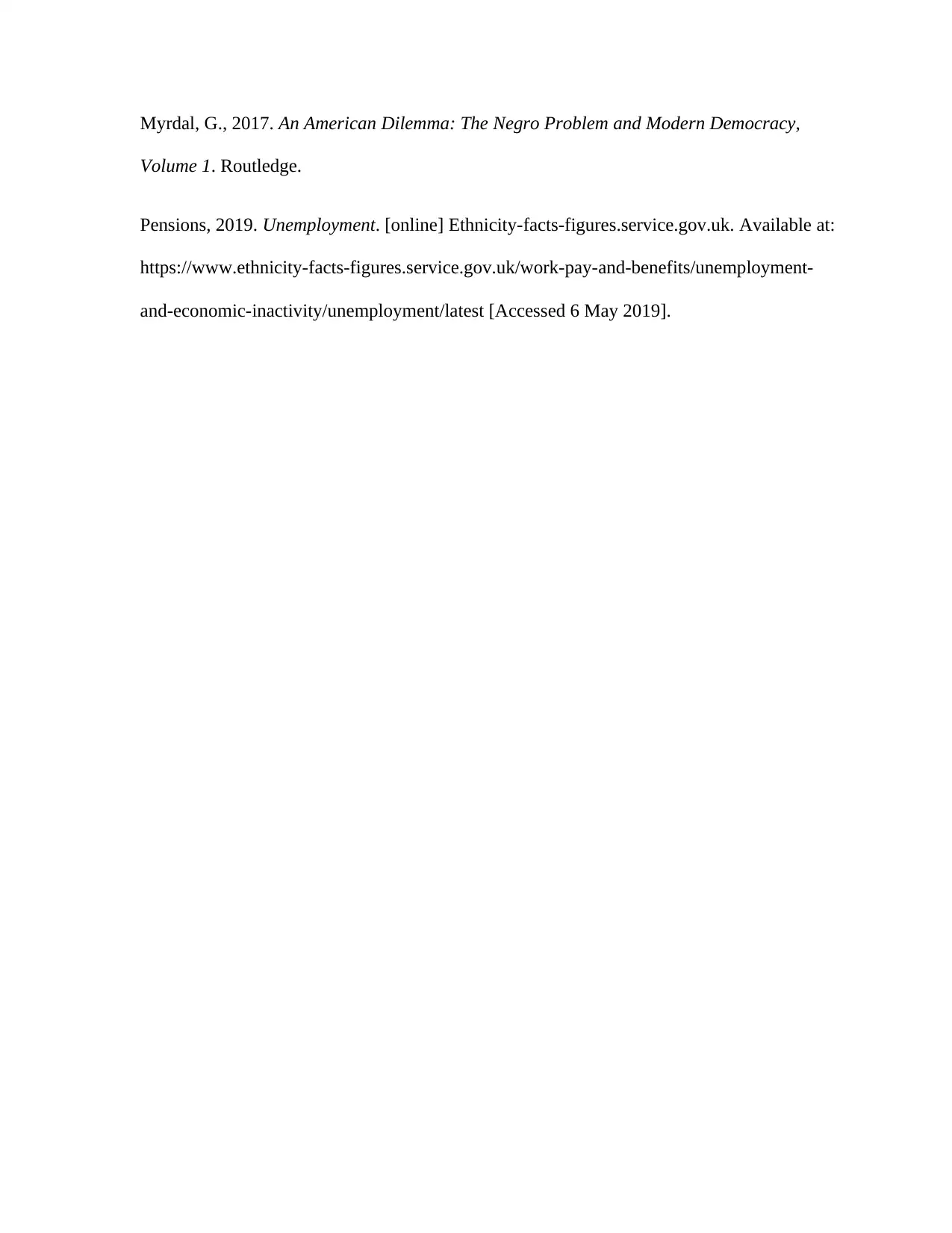
Myrdal, G., 2017. An American Dilemma: The Negro Problem and Modern Democracy,
Volume 1. Routledge.
Pensions, 2019. Unemployment. [online] Ethnicity-facts-figures.service.gov.uk. Available at:
https://www.ethnicity-facts-figures.service.gov.uk/work-pay-and-benefits/unemployment-
and-economic-inactivity/unemployment/latest [Accessed 6 May 2019].
Volume 1. Routledge.
Pensions, 2019. Unemployment. [online] Ethnicity-facts-figures.service.gov.uk. Available at:
https://www.ethnicity-facts-figures.service.gov.uk/work-pay-and-benefits/unemployment-
and-economic-inactivity/unemployment/latest [Accessed 6 May 2019].
⊘ This is a preview!⊘
Do you want full access?
Subscribe today to unlock all pages.

Trusted by 1+ million students worldwide
1 out of 9
Related Documents
Your All-in-One AI-Powered Toolkit for Academic Success.
+13062052269
info@desklib.com
Available 24*7 on WhatsApp / Email
![[object Object]](/_next/static/media/star-bottom.7253800d.svg)
Unlock your academic potential
Copyright © 2020–2025 A2Z Services. All Rights Reserved. Developed and managed by ZUCOL.





